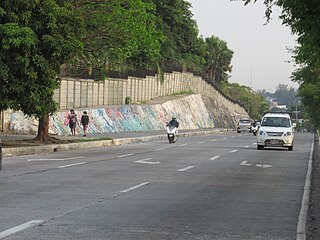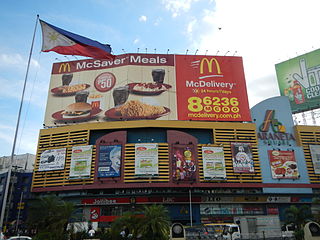
Quezon City, also known as the City of Quezon and Q.C., is the most populous city in the Philippines. According to the 2020 census, it has a population of 2,960,048 people. It was founded on October 12, 1939, and was named after Manuel L. Quezon, the second president of the Philippines.

San Jose del Monte, officially the City of San Jose del Monte, is a 1st class component city in the province of Bulacan, Philippines. According to the 2020 census, it has a population of 651,813 people, making it the largest local government unit within the province of Bulacan and Central Luzon, and the 18th most populated city in the Philippines.

Taguig, officially the City of Taguig, is the fifth-most populous city in the Philippines with a population of 1.2 million people. The city is one of the Philippines' cultural, financial, high-tech, entertainment and media centers with significant influence on commerce, health care, research, technology, education, politics, tourism, dining, art, fashion, and sports. Taguig is also an important center for the country's international diplomacy, hosting several embassies. It is also home to the headquarters of several major multinational corporations.

Antipolo, officially the City of Antipolo, is a 1st class component city and capital of the province of Rizal, Philippines. According to the 2020 census, it has a population of 887,399 people. It is the most populous city in the Calabarzon region, and the seventh most-populous city in the Philippines. It is also the most populated city under the component city status.

Caloocan, officially the City of Caloocan, is a 1st class highly urbanized city in Metro Manila, Philippines. According to the 2020 census, it has a population of 1,661,584 people making it the fourth-most populous city in the Philippines.

Malabon, officially the City of Malabon, is a 1st class highly urbanized city in the National Capital Region of the Philippines. According to the 2020 census, it has a population of 380,522 people.

Navotas, officially the City of Navotas, is a 1st class highly urbanized city in the National Capital Region of the Philippines. According to the 2020 census, it has a population of 247,543 people.

Carmona, officially the City of Carmona, is a component city in the province of Cavite, Philippines. According to the 2020 census, it has a population of 106,256 people.

Novaliches is a place that forms the northern areas of Quezon City, and encompasses the whole area of North Caloocan.

The Diocese of Novaliches is a diocese of the Latin Church of the Catholic Church in the Philippines. The diocese was created by Pope John Paul II on December 7, 2002, by virtue of his Apostolic Constitution Animarum Utilitati, and was canonically erected on January 16, 2003, from the Archdiocese of Manila. The diocese previously existed as the Ecclesiastical District of Quezon City-North, which was renamed the District of Novaliches in 2002.

The Quirino Highway, formerly called the El Quirino Express Road or Ipo Road, is a four-to-eight lane, secondary highway that connects Quezon City to the municipality of Norzagaray in Bulacan, Philippines. The road is designated as National Route 127 (N127) of the Philippine highway network within the city bounds of Quezon City, Radial Road 7 (R-7), and a spur of Radial Road 8 (R-8) of Metro Manila's arterial road network.

Novaliches Cathedral, canonically recognized as the Cathedral-Shrine and Parish of the Good Shepherd, is a Roman Catholic church located along Regalado Avenue in Barangay Fairview, Quezon City in the Philippines. It is the seat of the Diocese of Novaliches. It was established on August 5, 1975 by Manila Archbishop, Jaime Lachica Sin, who designated Fidelis Ruben Limcaco as the church's first parish priest.

Bagong Silang High School is the second largest public secondary school in Caloocan in Metro Manila and it was established on August 3, 1983.
Metro Manila, the capital region of the Philippines, is a large metropolitan area that has several levels of subdivisions. Administratively, the region is divided into seventeen primary local government units with their own separate elected mayors and councils who are coordinated by the Metropolitan Manila Development Authority, a national government agency headed by a chairperson directly appointed by the Philippine president. The cities and municipality that form the region's local government units are further divided into several barangays or villages which are headed by an elected barangay captain and barangay council.

Glorieta Park, sometimes spelled Glorietta Park, is an urban park in Caloocan, northern Metro Manila, the Philippines. It is situated near the border of barangays 187 and 188 in the former Tala Estate in North Caloocan. The park is one of three city-owned parks in Caloocan under the management of the Caloocan Parks Administration Services, the others being the Buena Park and Sports Complex in South Caloocan and the Caloocan Amparo Nature Park in eastern Tala, North Caloocan.
Barangay BF Homes Caloocan or Barangay 169 is a barangay of Caloocan, Metro Manila, Philippines. The barangay is known for having jurisdiction of the larger portions of the Banco Filipino-developed real estate projects in Northern Manila, and is considered the most affluent barangay in Caloocan.

Sucat is an administrative division in southern Metro Manila, the Philippines. It is an urban barangay in Muntinlupa City with many high-rise condominiums and commercial establishments in the area. The area is also well known for the Sucat exit of the South Luzon Expressway and Metro Manila Skyway.

Barangay 76 is a barangay of Caloocan, Metro Manila, Philippines. It is known for being the least populous barangay in Metro Manila, with a population of 2 according to the 2020 census. Formerly an agricultural land and later an informal settlement, it is currently predominated by commercial establishments.

























